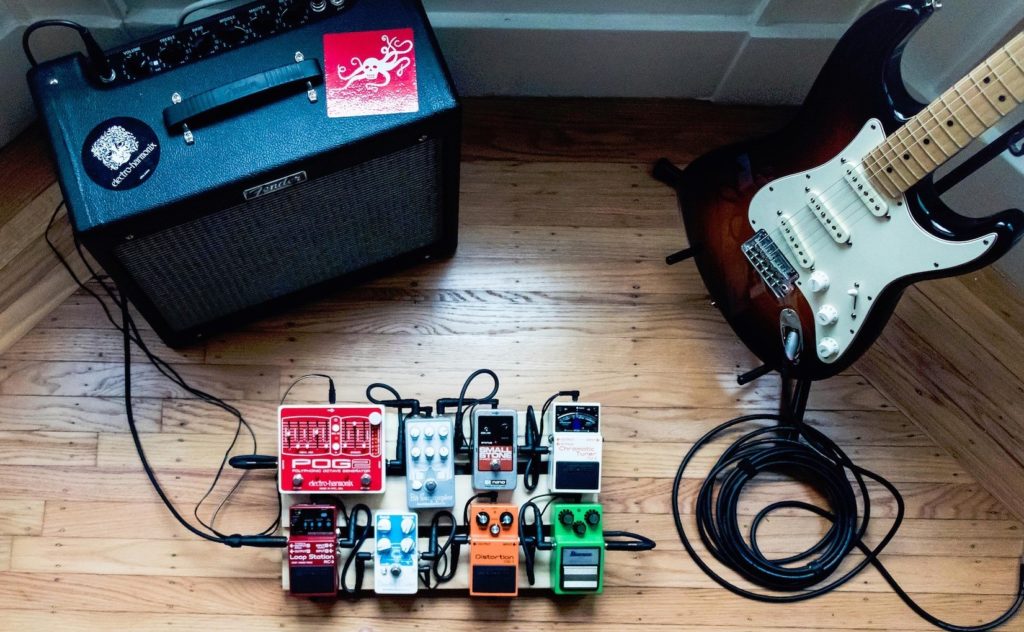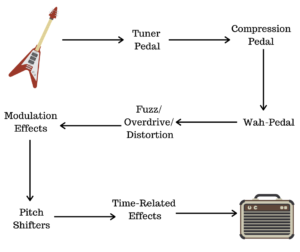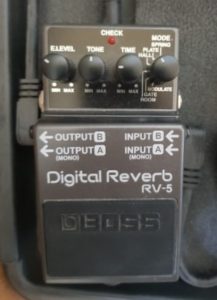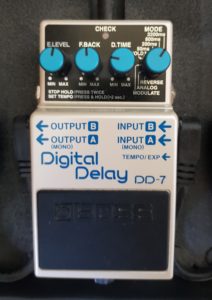Reverb and delay are two of the most popular guitar effects, but they’re often confused with each other. So what actually is the difference between reverb and delay? When should you use them? And how do they work?
In this article, I’ll go through all the key differences and similarities between reverb and delay guitar effects pedals. Then I’ll go through how and when to use them, plus the best pedals on the market. So let’s get started!
The Quick Answer
Reverb and delay effects are both time-based effects, so can be used to simulate a natural echo. Reverb occurs every time sound waves hit a surface, so they create an ambience which makes your tone sound livelier and gives it more depth and character. Instead, delay sounds like a note is being repeatedly played back.
What is a Delay Pedal?
First, we’ll start with delay effects pedals. Put simply, delay pedals take a note, and then play it back repeatedly. You can change the different parameters of the repeats. For example, how long the repeats go on for, the volume, and how long it takes for the repeated note to ring out, after the original one is played.
Delay pedals are super popular, and can be found on pretty much every professional guitarist’s pedal board.
There are three main different types of delay pedals.
- Analogue delay: these work by looping the original sound played by your guitar, back into the signal chain. With this type of delay, every note that is repeated gets weaker.
- Tape delay: this records the sound of your guitar onto a tape, and then plays it back. This is an old-school type of delay pedal.
- Digital delay: this converts your guitar signal and processes it so that you get longer delay times and more versatility.
- Slapback: this is a short, sharp form of delay, and sounds similar to echoing.
- Doubling: this has a super short decay time, which means you can barely notice the repeated note.
- Ping pong: this is caused by two delay effects on one unit. So if you used headphones, it would sound like the echo is coming from each side, in an alternating fashion.
- Long delay: this of course, means the decay time is longer and less sharp and punchy than slapback or doubling.
What is a Reverb Pedal?
Reverb pedals provide another basic effect that really has a big impact on the sound of your guitar. So, “reverb”, naturally occurs all the time. It’s simply the sound effect caused by sound waves reflecting off surfaces.
So think about the kind of sound effect you get if you were to shout in a huge empty hall. It causes a kind of echo effect right? Well, that’s reverb.
So how does this improve your guitar’s tone. Reverb tends to add more depth and presence to your sound. It’s great for loads of different situations, from soloing to rhythm guitar. It gives your tone a natural sounding boost, that makes it stand out and sound warmer and fuller.
There are 5 main types of reverb. Some effects pedals allow you to switch between the types, and others simply allow you to control how much reverb you hear. Here are the main types:
- Room: this is the most subtle type of reverb. It’s almost so subtle, that if you have it on fairly low, you will really have to listen for it.
- Hall: this makes the reverb more obvious, since it’s supposed to mimic the natural reverb that occurs when you play in a hall.
- Chamber: this differs from hall reverb, because it mimics a smaller space, resulting in more clarity, and makes it sound less airy.
- Plate: this reverb type mimics the sound you get if a sound wave hits a plate of metal. This type of reverb sounds smooth and lasts for a longer time.
- Spring: this type of reverb sounds more wobbly, hence mimicking the way a spring moves. The reverb is less smooth than plate reverb.

How are They Similar?
So now you know what reverb and delay pedals actually are, let’s jump into some of the similarities.
Reverb and delay effects are often confused because they both can be described as “echo” type effects. This is because they fall into the time-based effects category. This means that they both add an effect, after the original sound of your guitar is heard.
This is different to a lot of other effects types like wah, distortion or overdrive, which impact the original sound of your guitar.
How are They Different?
Okay, so reverb and delay are both time-based effects, but why do they sound differently.
Well, although they both use a kind of echo effect, there are some key differences. Take this example.
If you were to clap your hands loudly, you would get reverb naturally occurring, when the sound of the clap hits other surfaces like the walls of a room. This gives you an echo type of effect.
Delay, on the other hand, would occur if you clapped your hands, and then continued to clap them repeatedly, with a little less force each time. See the difference?
They both of sound like an echo, but reverb occurs immediately after, and kind of elongates the sound to give it more depth. Whereas delay, sounds like the sound is made repeatedly.
When to Use Reverb and Delay
Now you know the differences between reverb and delay effects, it’s a good time to jump into when to use each type of pedal to get different kinds of results.
when to use reverb
Generally, a lot of guitarists will benefit from using reverb subtly in a lot of different situations. Personally, I use it pretty much all the time. When playing overdriven chords, I find it gives my tone more depth. And when playing solos, reverb definitely gives your notes more presence.
when to use delay
Delay, on the other hand, is usually best used sparingly. Unless you’re using slapback or doubling type delay, which can be used more often, and even all the time to give you that similar increase in depth that reverb provides. I find that it’s best to use delay more obviously in more specific situations, for example when playing solos.
when to use both together
If you’re using both reverb and delay subtly, it can sometimes be a good idea to use them together. Again, unless you’re using a shorter decay time with the delay, it’s best to only really use both effects in specific situations, for example lead sections of a song.
How to Use Reverb and Delay
Now let’s jump into how exactly to use reverb and delay, alone, and in combination with one another.
How to use reverb
Reverb is best used to create an ambience. Like I mentioned before, there are several types of reverb:
- Room: this is the most subtle.
- Hall: this gives you a more obvious reverb effect.
- Chamber: this gives you an obvious reverb effect, but it sound tighter than hall-type reverb.
- Plate: this type sounds smoother and lasts longer.
- Spring: this type of reverb sounds more wobbly.
You’ll usually be able to adjust the following parameters with these controls on a reverb pedal:
- Decay: this refers to how long the echo effect lasts.
- Attack: this refers to how quickly the reverb effect kicks in.
- Mix or level: this refers to the balance between the volume of your guitar’s natural sound, and the reverb.
So, if you’re looking for a very subtle reverb effect, you’ll want to use room or plate type reverb usually. You’ll also want the decay time to be low, the attack to be fast, and the level to be low.
On the other hand, if you want to make it sound like you’re playing in a huge empty space, then use hall-type reverb, with a long decay time, and high level.
There are lot’s of different parameters, so have a play about and see what sounds good with your guitar and amplifier.
How to use delay
With delay pedals, you’ll also want to go through a similar process as you would with a reverb pedal. You can first begin by selecting the type of reverb you want, and then adjust the individual parameters to dial in the perfect effect.
Here’s a reminder on the different types of delay.
- Doubling: sounds very natural and sharp.
- Slapback: a short, quick style of delay.
- Long delay: this sounds the most obvious.
- Ping-pong: this adds an interesting type of delay that bounces from one direction to the next.
Now let’s go through the different controls you’ll often find on delay pedals:
- Time: this refers to the length of time between the sound of your guitar, and the repeated note.
- Feedback: this refers to the number of repeats the delay pedal will induce.
- Level: this refers to the volume of the delayed notes.
If you’re looking for your delay pedal to give you more fullness and depth to your tone, as opposed to an obvious series of repeated notes, then you’ll want to use doubling or slapback delay. Then you’ll want the time between your original note, and the repeated note to be very sharp, and the the feedback and level to be super low.
On the other hand, if you want an obvious series of repeated notes, then use long delay, have the feedback and level high, then adjust the time according to whether you want the repeats to kick in quickly or slowly.
Check out my guide to using a delay pedal for more information.
How to use both together
When using both reverb and delay together, you want to start off with the reverb effect. This is usually the best step, whether you want the reverb and delay pedals to create very different effects, or you both want them to contribute to an overall echo effect.
Follow the same steps as above to dial in your reverb effect. Then, move onto adjusting your delay pedal. Always make sure you only adjust one control at a time, so you can tell exactly what the changes are doing to your tone. It can take a bit of time, but you’ll get better results this way.
Don’t go overboard either. Reverb and delay are usually best when they’re used more subtly, particularly if you don’t want an artificial sounding tone.
Pedal Chain Placement
If you’re using multiple pedals, then you’ll need to think carefully about where you should place each of them in your chain to get the best effect. Of course, there are no strict rules with pedal chain placement, only opinions. So experiment, and try your pedals in different positions and see which sound you like the most.
With that said though, generally, most guitarists agree that delay and reverb pedals sound best when they’re at the end of the chain (closest to the amplifier). This is because they are both time-based effects.
So, if you were to place them at the start of your chain, you’d be altering the effect of every other pedal you’re using significantly. This can get messy. For example, it doesn’t usually sound all that great if you start distorting a delay pedal.

what if you’re using reverb and delay?
So generally, it’s best to put time-based effects (reverb and delay) at the end of the pedal chain, but which order should you put them in if you’re using reverb and delay pedals at the same time.
Well, this is where things get pretty debatable. A lot of guitarists disagree about this topic, so your best bet is to try both pedal chain orders, and see which sounds best to you. But here’s a quick summary on what happens when you put delay before reverb and vice-versa.
If you put your delay pedal before your reverb, you would be creating a series of repeated notes, and then giving them more depth and liveliness. This tends to sound the most natural.
If you put the reverb pedal before the delay pedal, then you’ll be adding depth and presence, and then creating a series of repeated notes of this tone. This creates bigger washes of sound.
Check out this guide to reverb and delay pedal placement to learn more.
Best Reverb and Delay Effects
So if you’ve not already purchased a reverb or delay pedal, then you’re probably wondering what the best ones are so you can go ahead and start using these super cool effects!
There are a million and one different guides out there on the “ten best reverb and delay pedals”, but if I’m honest, I don’t think they’re all that useful. When I was shopping for my first pedals, all they did was confuse me.
So instead of simply listing ten of the most popular pedals, I’ll just talk about my favourite ones that I think sound great.
Best reverb pedal
The Boss RV reverb pedal is a great option to go for if you want this kind of effect. It’s versatile and easy to use most importantly. But it’s also a really well-made pedal in terms of the build quality. It’s sturdy and solid, so you’ll have no problems if you want to take it gigging with you.

best delay pedal
The Boss DD-7 Digital Delay Pedal is a solid option in this category. Like with all Boss pedals, they’re built to last and they look great on every pedal board. You’ll get a high quality delay function and plenty control over the parameters like the volume, number of repeats etc.

amp with delay and reverb
If you’re not all that fussed about pedals, and you just want an amplifier with built-in effects, then take a look at the Blackstar Core iD series. I use one as a practise amp and love it. It comes with 6 channels, built-in effects presets and is really versatile. It’s really good if you’re on a budget too. You can pick the Blackstar Core ID 10W amplifier on Guitar Center for a great price.

FAQs
Don’t worry if you still need some more answers about delay and reverb pedals. Here are some frequently asked questions.
which is better, reverb or delay?
There isn’t really a clear cut answer to this question. It just depends on what type of effect you are looking for.
If you want a way to create a tone which sounds more lively and has more depth, then you’ll probably find that reverb is more effect.
But if you’re looking to add a most specific and unique effect by repeating notes to make your tone sound fuller, then delay will be your best option.
can you make a delay pedal sound like reverb?
do I need delay and reverb pedals?
It really depends on what type of effect you’re after. If you only want to add more presence, with an echo type effect, then you’ll probably only really need a reverb pedal. But if you want to repeat notes to create a more specific effect, then you’ll benefit from getting a delay pedal too.
Delay pedals are usually best for lead guitar sections, so if you only play rhythm, then you probably won’t benefit that much from a delay effect.
Summing Things Up
Nearly there! Thanks for making it near the end of this article, hopefully it’s answered all your questions about reverb and delay pedals. I know it’s been a pretty hefty post, so here are a few take home messages to keep in mind.
- Delay pedals take a note or chord and repeatedly play it back.
- Reverb pedals emphasise the natural sound you’d get if you played in a large room or hall.
- Both effects, are time-based, so create an echo type sound.
- However, they don’t sound the same. Reverb creates an ambience, whereas delay creates repetition.
- Reverb is great in loads of situations and can be used all the time to give more depth and presence.
- Delay, should be used more sparingly and for a specific effect.
- If you’re using both effects together, then dial in your reverb pedal first, then turn on your delay pedal and adjust the settings.
- Generally, reverb pedals sound better after delay pedals in the chain (so closer the the amp).
So there you go! That’s an-indepth comparison between reverb and delay pedals! I hope you’ve found this article helpful, thanks for reading. Here are some other posts you might find useful:
